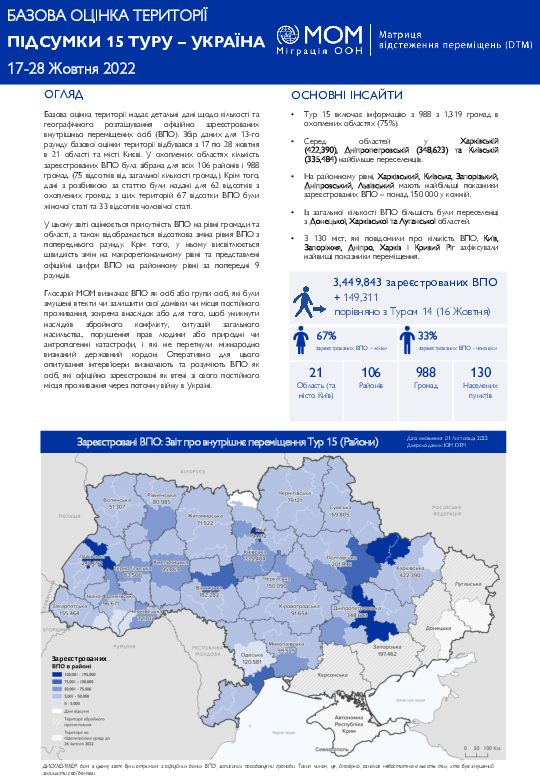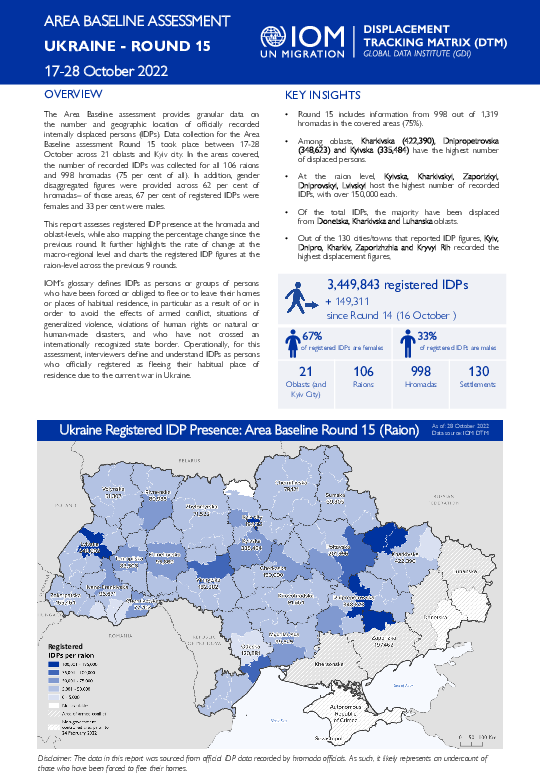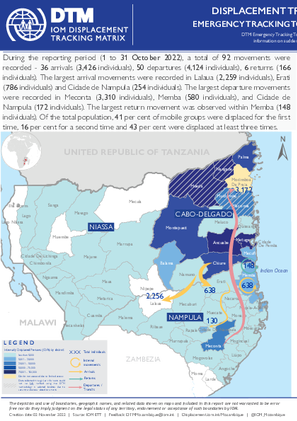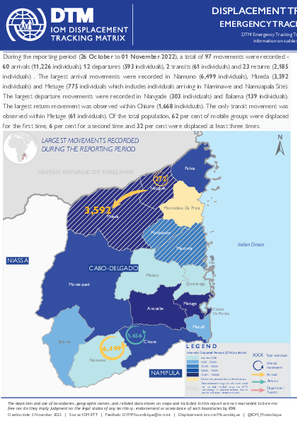-
Countries
-
Data and Analysis
-
Special Focus
-
Crisis Responses

Contact
DTMUkraine@iom.int
Language
Ukrainian
Location
Ukraine
Period Covered
Oct 17 2022
Oct 28 2022
Activity
- Baseline Assessment
Базова оцінка території надає детальні дані щодо кількості та географічного розташування офіційно зареєстрованих внутрішньо переміщених осіб (ВПО). Збір даних для 13-го раунду базової оцінки території відбувався з 17 по 28 жовтня в 21 області та місті Києві. У охоплених областях кількість зареєстрованих ВПО була зібрана для всіх 106 районів і 988 громад (75 відсотків від загальної кількості громад). Крім того, дані з розбивкою за статтю були надані для 62 відсотків з охоплених громад: з цих територій 67 відсотки ВПО були жіночої статі та 33 відсотків чоловічої статі.

Contact
DTMUkraine@iom.int
Language
English
Location
Ukraine
Period Covered
Oct 17 2022
Oct 28 2022
Activity
- Baseline Assessment
The Area Baseline assessment provides granular data on the number and geographic location of officially recorded internally displaced persons (IDPs). Data collection for the Area Baseline assessment Round 15 took place between 17-28 October across 21 oblasts and Kyiv city. In the areas covered, the number of recorded IDPs was collected for all 106 raions and 998 hromadas (75 per cent of all). In addition, gender disaggregated figures were provided across 62 per cent of hromadas– of those areas, 67 per cent of registered IDPs were females and 33 per cent were males.

Contact
DTM Support — iomdrcdtm@iom.int
Language
English
Location
Democratic Republic of the Congo
Period Covered
Oct 20 2022
Oct 31 2022
Activity
- Mobility Tracking
- Event Tracking
Depuis le 20 octobre 2022, les affrontements entre les Forces Armées de la République Démocratique du Congo (FARDC) et les combattants présumés de l'ex-rébellion du M23 ont repris dans les villages de Rangira, Rwanguba, Kabindi et Matebe dans le groupement de Jomba, dans le village de Ntamugenga dans le groupement de Bweza, et Rubare, Kako et Kalengera dans le groupement de Kisigari, dans la chefferie de Bwisha, dans le territoire de Rutshuru. Ces affrontements se sont poursuivis et étendus simultanément à plusieurs villages du territoire de Rutshuru, atteignant le centre de Rutshuru et l'agglomération de Kiwanja ainsi que plusieurs localités au sud de Rutshuru sur la Route Nationale #2, jusqu'au groupement de Rugari dans la chefferie de Bwisha, située à environ 35 km de la ville de Goma, toujours dans le territoire de Rutshuru, provoquant d'importants mouvements de population et une crise humanitaire prolongée. Au total, 16 319 ménages, soit 90 894 personnes, ont été contraints de quitter des zones de haute tension pour des zones considérées comme relativement stables au sein des communautés d'accueil et des centres collectifs. La majorité des personnes déplacées se trouvent sur l'axe Nord Kiwanja - Kanyabayonga et dans ses environs. Un assez grand nombre d'entre elles sont allées en Ouganda via la frontière de Bunagana, au nord vers Lubero, d'autres à l'ouest vers Tongo et au sud vers le territoire de Nyiragongo avec quelques mouvements observés vers la ville de Goma.

Contact
DTM Somalia, IOMSomaliaDTM@iom.int
Language
English
Location
Somalia
Period Covered
Oct 15 2022
Oct 19 2022
Activity
- Mobility Tracking
- Event Tracking
Since November 2021, 313,618 individuals have been displaced by drought in Gedo region. Since round 32, an estimated 5,937 IDPs arrived at the assessed settlements.

Contact
DTMMozambique@iom.int
Language
English
Location
Mozambique
Period Covered
Oct 01 2022
Oct 31 2022
Activity
- Mobility Tracking
- Event Tracking
During the reporting period (1 to 31 October 2022), a total of 92 movements were recorded - 36 arrivals (3,426 individuals), 50 departures (4,124 individuals), 6 returns (166 individuals). The largest arrival movements were recorded in Lalaua (2,259 individuals), Erati (786 individuals) and Cidade de Nampula (254 individuals).
The largest departure movements were recorded in Meconta (3,310 individuals), Memba (580 individuals), and Cidade de
Nampula (172 individuals). The largest return movement was observed within Memba (148 individuals). Of the total population, 41 per cent of mobile groups were displaced for the first time, 16 per cent for a second time and 43 per cent were displaced at least three times.

Contact
DTM Nigeria, AllUsersInDTMNigeria@iom.int
Language
English
Location
Nigeria
Period Covered
Oct 24 2022
Oct 30 2022
Activity
- Mobility Tracking
- Event Tracking
The DTM Emergency Tracking Tool (ETT) is deployed to track and to collect information on large and sudden population movements, provide frequent updates on the scale of displacement and quantify the affected population when needed. As a sub-component of the Mobility Tracking methodology in Nigeria, ETT utilises direct observation and a broad network of key informants to capture best estimates of the affected population per location, enabling targeted humanitarian response planning.
Between 24 and 30 October 2022, a total of 1,097 new arrivals were recorded in locations in Adamawa and Borno States. The new arrivals were recorded at locations in Askira/Uba, Bama, Dikwa, Damboa, Gwoza, Kala Balge, Monguno and Ngala Local Government Areas (LGAs) of the most conflict-affected state of Borno and in Fufore, Gombi, Girei, Hong, Lamurde, Michika, Maiha, Mubi South, Song, Yola North and Yola South LGAs of Adamawa State.

Contact
DTMMozambique@iom.int
Language
English
Location
Mozambique
Period Covered
Oct 26 2022
Nov 01 2022
Activity
- Mobility Tracking
- Event Tracking
During the reporting period (26 October to 01 November 2022), a total of 97 movements were recorded - 60 arrivals (11,226 individuals), 12 departures (593 individuals), 2 transits (61 individuals) and 23 returns (2,185 individuals) . The largest arrival movements were recorded in Namuno (6,499 individuals), Mueda (3,592 individuals) and Metuge (775 individuals which includes individuals arriving in Naminawe and Namuapala Site).
The largest departure movements were recorded in Nangade (303 individuals) and Balama (139 individuals). The largest return movement was observed within Chiure (1,668 individuals). The only transit movement was observed within Metuge (61 individuals). Of the total population, 62 per cent of mobile groups were displaced for the first time, 6 per cent for a second time and 32 per cent were displaced at least three times.
Contact
iombeirut@iom.int
Location
Lebanon
Activity
- Migrants presence
- Mobility Tracking
- Baseline Assessment
Period Covered
May 01 2022 -Jul 31 2022
The MPM assessment follows the methodology of IOM’s global Displacement Tracking Matrix (DTM) Mobility Tracking component. Tailored to the operational context in Lebanon, the MPM assessment analyzes data to provide multi-layered information on the presence and mobility of migrants. This assessment aims to complement existing data collection exercises and it is implemented in coordination with key actors to maximize synergies, interoperability and avoid duplication.
In the second round of the MPM survey, an estimated 135,420 migrants were identified, compared to 207,696 in 2021, indicating a 35% decrease in the number of migrants. These migrants primarily reside in urban areas, with Mount Lebanon (56%) and the Beirut governorate (18%) reporting the highest proportions of the identified migrant population.
During this rounf, 2,337 neighborhoods across 26 districts and 8 governorates were covered. Surveys for 1,598 cadasters were completed, which amounts to a coverage of 99.3% of all cadasters in Lebanon.
The majority of migrants identified in Lebanon come from Ethiopia (37%), Bangladesh (22%), and Sudan (8%). Among the migrants, 76% are female, while 26% are male. It's worth noting that the female-to-male ratio varies by nationality, with 99% of Ethiopians and 97% of Filipinos being female, while only 24% of Egyptians and 26% of Sudanese are female.
Population Groups
Survey Methodology
Unit of Analysis Or Observation
Type of Survey or Assessment
Keywords
Geographical Scope
Administrative boundaries with available data
The current dataset covers the following administrative boundaries

Contact
DTMcovid19@iom.int
Language
English
Location
Global
Period Covered
Oct 24 2022
Oct 31 2022
Activity
- Other
The DTM Global Mobility Restrictions Overview provides updates on international air travel restrictions and conditions for authorized entry. This overview aims to understand how COVID-19 has impacted human mobility, detailing how global and regional trends in air travel measures have evolved since COVID-19 was declared a global pandemic in March 2020. The data presented focuses on the changes in public health-related immigration and border management measures. It provides information intended to support IOM missions and partners in targeted response planning and advocacy for vulnerable populations who may be affected by changes in global mobility.

Contact
REMAPBD@iom.int, rdhroap@iom.int, dtmremapsupport@iom.int
Language
English
Location
Bangladesh
Snapshot Date
Dec 31 2021
Activity
- Other
This snapshot report on remittance inflows to Bangladesh during COVID-19 is part of IOM's EU-funded project Displacement Tracking Matrix - Regional Evidence for Migration Analysis and Policy (DTM) and the Asia Pacific Regional Data Hub (RDH). The inflow of remittances is one of the main driving forces in Bangladesh’s economic growth and development (IOM, 2021b). Remittances support the economy by increasing foreign exchange reserves and national savings, and reducing poverty levels (Chowdhury and Chakraborty, 2021). As a result of the COVID-19 global crisis and the decrease in overseas Bangladeshi migrant workers, the inflow of remittances to the country was initially predicted to decline significantly in 2020 (ADB, 2020; World Bank, 2020a). However, contrary to all negative forecasts, recorded remittance inflows to Bangladesh remained resilient (IOM, 2021a; IOM, 2022).